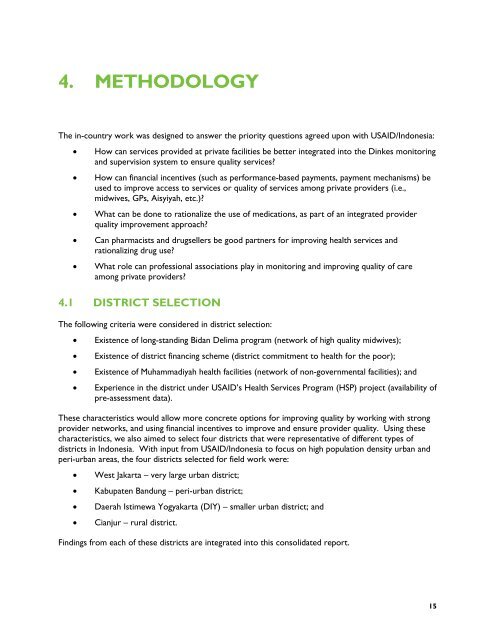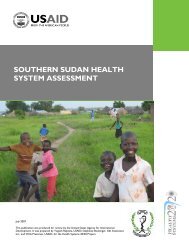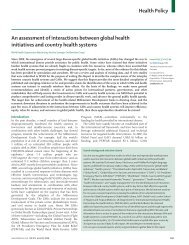PRIVATE SECTOR HEALTH CARE IN INDONESIA - Health Systems ...
PRIVATE SECTOR HEALTH CARE IN INDONESIA - Health Systems ...
PRIVATE SECTOR HEALTH CARE IN INDONESIA - Health Systems ...
- No tags were found...
You also want an ePaper? Increase the reach of your titles
YUMPU automatically turns print PDFs into web optimized ePapers that Google loves.
4. METHODOLOGYThe in-country work was designed to answer the priority questions agreed upon with USAID/Indonesia:• How can services provided at private facilities be better integrated into the Dinkes monitoringand supervision system to ensure quality services?• How can financial incentives (such as performance-based payments, payment mechanisms) beused to improve access to services or quality of services among private providers (i.e.,midwives, GPs, Aisyiyah, etc.)?• What can be done to rationalize the use of medications, as part of an integrated providerquality improvement approach?• Can pharmacists and drugsellers be good partners for improving health services andrationalizing drug use?• What role can professional associations play in monitoring and improving quality of careamong private providers?4.1 DISTRICT SELECTIONThe following criteria were considered in district selection:• Existence of long-standing Bidan Delima program (network of high quality midwives);• Existence of district financing scheme (district commitment to health for the poor);• Existence of Muhammadiyah health facilities (network of non-governmental facilities); and• Experience in the district under USAID’s <strong>Health</strong> Services Program (HSP) project (availability ofpre-assessment data).These characteristics would allow more concrete options for improving quality by working with strongprovider networks, and using financial incentives to improve and ensure provider quality. Using thesecharacteristics, we also aimed to select four districts that were representative of different types ofdistricts in Indonesia. With input from USAID/Indonesia to focus on high population density urban andperi-urban areas, the four districts selected for field work were:• West Jakarta – very large urban district;• Kabupaten Bandung – peri-urban district;• Daerah Istimewa Yogyakarta (DIY) – smaller urban district; and• Cianjur – rural district.Findings from each of these districts are integrated into this consolidated report.15
















